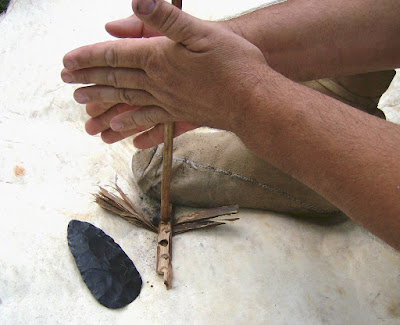The ability to make primitive fire, breaks down to several major methods: percussion, compression, and friction. Then there are subdivisions of those. Percussion would consist of striking sparks off of pyrites, or some bamboos, with flints. Compression is done with a specially constructed fire piston. Friction has the largest variation of potential technics, between rotating methods and sawing/linear technics. The methods that involve rotating a spindle against a fireboard include hand drills, bow & drill, strap drill, and pump drill. The sawing/linear friction technics consist of the fire plow, fire thong, Rutger roll, and fire saw variations. Pictured is the hand drill friction fire method. A straight slender shaft of appropriate wood is spun between the palm of the hands, against a light/medium density wood fireboard. There is a notch cut into the forming depression. Fibers are ground off the drill and fireboard, that build up in the notch. The heat from the friction generates an ignition temperature around 400 - 800 degrees F., combusting the fibers into a hot smoldering coal. To make fire you need to place the coal into a nest of combustible materials, and spread and increase the temperature, by blowing into it, till it bursts to flame.
Subscribe to:
Post Comments (Atom)





No comments:
Post a Comment